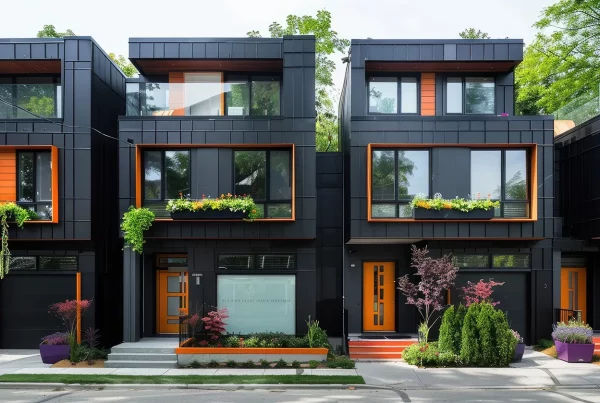Multi-Generational Homes Explained. Considering the current housing crisis, many American families are harnessing the power of multi-generational home financing. Multi-generational living empowers families by creating accessibility for shared homeownership through maximizing resources and collaboration. Devising solutions for these challenges requires innovation. As a way forward, many are consolidating multiple incomes and properties and creating a single living space to accommodate the whole family.
Discover the ins and outs of multi-generational properties, how they work, and who they work for. Learn how to access the resources that provide the fundamental shift in housing dynamics. For many, highlighting the importance of family and redefining collaboration and mutual support within the American family begins by embracing change.
The Definition of Multi-Generational Homes:
The CDC classified a multigenerational household during the pandemic for early vaccine eligibility. They determined multigenerational living as three generations or more living within the same home. Simply put, multi-generational living is when parents, grandparents, and children share a single house.
What is a Skipped Generation home?
In the modern era of housing, we categorize grandparents who live in a home with their adult grandchildren (25 and older) as a “skipped generational home.”
Why are so many families considering cohabitation?
As rental prices continue to climb, blended generational living redefines the American dream by becoming a practical solution for families in the face of inflation. The multifaceted solution not only addresses the financial concerns of adult children but also serves as a compassionate and affordable option for elderly family members. Today’s demand for eldercare is fierce, and availability is scarce, especially for those with specialized care, like dementia patients. Social Security income often falls short and rarely covers the high cost of assisted living facilities, and commonly, all assets, including real estate, serve as collateral for repayment.
The Shifting Tides of American Homeownership
We must return to the history books to fully understand today’s buyers. On top of the buyers list are the Baby Boomers. Boomers came of age during an ideal housing climate. Owning a home was second nature to their generation. Today, Boomers and the Silent Generation’s real estate investments, life savings, and retirement allow them to dominate the housing market.
To the younger generations, the older generations purchased their homes at peanut prices, considering the median sale price for a home in 2024 is $402,523. As Business Insider said, “The silver Tsunami” now dominates the housing market by using their equity to edge out the younger generation.
In contrast, the Millennial generation has historically struggled in the housing market. The combination of heavy student debts, inflation, and the widespread shorting crisis places Millenials and Gen Z at risk of renting for the foreseeable future. The solution to these housing struggles spawns ingenuity.
As a result, many American families choose to either occupy one multi-family property or assist the younger generation with the expenses associated with buying a home. The COVID pandemic and the global shutdown of commerce drove home the importance of family. According to the Pew Research Center, 33% of Americans report the positive impact of being able to spend more time with family during the pandemic. In any case, families are choosing to be closer geographically.
The Evolution of the Multigenerational Family.
In the current housing climate, there are three categories of demographics to consider. To begin with, many younger Americans struggle to qualify for first-time loan qualification. Today’s soaring interest rates and the lack of affordability often deter adult children from seeking homeownership on their own.
Shifting gears to the living situations of the next generation, the middle-agers of America, many of whom already own a single-family home, are reporting they need more personal space. For many, their adult children are still living at home due to the rising cost of housing and the lack of real estate market availability. Additionally, the elderly adult generations are overwhelmed by the staggering costs associated with caregiving and the extended living needs of aging. In today’s society, extended family members often accommodate the needs of older adults to offset the cost and allow them to remain in their preferred living spaces.
Economic hardships
Economic hardships lead to ingenuity in the younger generation when buying homes. As a solution to the rental cycle, American families are creating support systems for buying homes with their children and grandchildren, resulting in multigenerational housing. While many seniors require a smaller home, and retirement is an ideal time to downsize, others need better care and companionship. In these situations, many seniors decide to move to a new location and secure a better home for their futures.
In contrast, the younger generation has various needs, including larger homes for growing families and lifestyle expansion. The solution is simple: one dwelling that encompasses each family member’s needs. According to the National Association of Realtors’s NAR Report trends, “14% of home buyers purchased a multi-generational home to take care of and spend time with aging parents because children over 18 were moving back and for cost savings. Eighteen percent of Older Boomers purchased a multi-generational home. Gen Xers comprised the second largest share at 17%.”
Designing a Multi-Generational Home.
More often than not, multi-gen homes require house plans that prioritize functionality. Homeowners must think long-term to create the perfect home for solace, companionship, and mutual assistance. Of course, each family will have unique living arrangements. However, home plans that accommodate both future needs and current living dynamics work best. Generally, whether multigenerational clients are building a new home or repurposing an existing property, home builders and realtors recommend home designs with first-floor plans and living areas to accommodate every aspect of caregiving. In addition, Certified Aging-in-Place Specialists (CAPS) are an excellent resource for multi-generational families to assist them in identifying the expansive demands of coexisting under one roof.
Creating separate spaces for childcare and the younger generation from the elderly living quarters helps in two ways. For one, the older generation will appreciate the extra space away from the children to relax and unwind from their noise and energy levels. On the flip side, kids need to play. After all, childhood is exciting and filled with adventure and imagination, so strategic planning allows children to enjoy those incredible moments.
Since multigenerational families regularly run on different schedules, planning ahead for parking and separate entrances helps maximize shared resources. Streamlining the balance of the home by adding in-law suites with kitchenettes and a small living room accommodates the schedules and needs of elderly family members or adult children. Overall, the more planning and attention multi-gen families put into the functionality of a prospective home, the better they meet the diverse needs of their modern family.
Popular Universally Designed Multigenerational Home Features:
- Soundproof interior walls
- Multiple laundry areas
- Individual HVAC zoning
- Large accessibility-focused bathrooms with grab bars
- Separate entrances
- Kitchenettes and additional living rooms
- Multiple Primary Bedrooms
- Large sleeping areas to accommodate any dynamic. Ie, wheelchairs, workspaces, and toys
- Accident-proof the property for both children and elderly family members
- Large open-access shared spaces for wheelchairs
- Storage areas
- Privacy accommodations
- No-step entry throughout the property
- Non-slip surfaces
- Lever door handles
- Bright lighting and dimmer switches
Challenges Surrounding Multi-Generational Home Financing.
Since housing prices reached staggering heights in 2023, and following the pandemic, many Americans chose to move closer to family members and loved ones. As our economy recovers, many people yearn to own a home. For many homebuyers, locations closer to the family support system are desirable. We must return to the history books to fully understand today’s buyers.
On top of the buyers list are the Baby Boomers. Boomers came of age during an ideal housing climate. From a millennial’s perspective, their predecessors purchased their homes at peanut prices. As Business Insider said, “The silver Tsunami” now dominates the housing market by using their equity to edge out the younger generation. In contrast, the Millennial generation has struggled in the housing market. The combination of heavy student debts, inflation, and the widespread shorting crisis places Millennial’s and Gen Z at risk of renting for the foreseeable future.
“More young adults today live with their parents than in the past. Among those ages 18 to 24, 57% live in a parent’s home, compared with 53% in 1993.” PEW Research
According to the National Association of Realtors’s NAR Report trends, “ Twenty-seven percent of younger millennials cited that saving for a down payment was the most challenging step in the home buying process, compared to just 1% for older boomers. Nearly one in three – 29% – of younger millennials received down payment help through a gift or loan from a friend or relative, and 24% lived with friends or family, directly saving on rental costs.”
How are Multigenerational Households Acquiring Loan Approval?
Multigenerational loan qualification is a reasonably straightforward process. Although there isn’t a limit to the number of loan applicants for a mortgage, the general cap is four people. Each applicant must supply supporting documentation beginning with credit scores; each loan applicant must have a credit score above 620 as a general rule. Secondly, debt-to-income ratios (DTI) lower than 50% are preferred. Lastly, proof of steady income and assets assures the borrower of financial legitimacy.
The Basic Requirements for Loan Approval:
- 620 minimum credit score for eligibility.
- (DTI) can be no more than 45%
- Minimum down payment of 3%, or 20%, to avoid PMI
- Appraisal of property to verify its value
Best Practice Multi-generational Home Rules
- Get the contract drawn up by a lawyer
- Determine who can live within the property
- Plan for the unexpected. (Deaths, marriages, and relocations)
- Each party needs to plan their estate using assets to protect the property from default
Financing and embracing Multi-Generational Living
By implementing this practical solution to the affordability challenges, many families can strengthen their bonds and regain the solidarity of their heritage. Pooling resources and learning to live a life of adaptability isn’t foolproof. However, neither is the cost of living and having adult children stuck in the unaffordable and relentless rental cycle. Mortgage lenders regularly collaborate with real estate agents and professional community organizers to create specialized loan products tailored toward various housing options, including multi-generational living. Unlocking the door to a shared family property begins by learning how they work; collaborating with a lending professional to secure a loan is key.
The steps are simple:
1. Schedule a Call: An experienced loan officer can discuss your lending needs and guide you through the possibilities.
2. Get Approved: We’ll help you through the mortgage application process and facilitate the steps for approval.
3. Exhale: Put your feet up and feel secure knowing you made the best decisions about your home loan.
With proper guidance, you can get your first home, accommodate your growing family, and start that renovation project—whatever goal is on the horizon. An alliance with Mortgage Insiders will give you the confidence to know that your mortgage loan is setting you up for financial success. Mortgage Insiders offers today’s latest financial news and mortgage trends. Check out their channel for current events.





